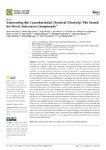Mostrar o rexistro simple do ítem
Uncovering the Cyanobacterial Chemical Diversity: The Search for Novel Anticancer Compounds
| dc.contributor.author | Ferreira, Leonor | |
| dc.contributor.author | Sousa, Maria Lígia | |
| dc.contributor.author | Ribeiro, Tiago | |
| dc.contributor.author | Morais, João | |
| dc.contributor.author | Forero, Abel M. | |
| dc.contributor.author | Branco, Raquel Castelo | |
| dc.contributor.author | Leão, Pedro N. | |
| dc.contributor.author | Preto, Marco Aurélio Correia | |
| dc.contributor.author | Urbatzka, Ralph | |
| dc.contributor.author | Szemerédi, Nikoletta | |
| dc.contributor.author | Spengler, Gabriella | |
| dc.contributor.author | Jiménez, Carlos | |
| dc.contributor.author | Rodríguez, Jaime | |
| dc.contributor.author | Vasconcelos, Vitor | |
| dc.contributor.author | Reis, Mariana | |
| dc.date.accessioned | 2023-10-20T19:38:48Z | |
| dc.date.available | 2023-10-20T19:38:48Z | |
| dc.date.issued | 2022-09-15 | |
| dc.identifier.citation | Ferreira, L.; Sousa, M.L.; Ribeiro, T.; Morais, J.; Forero, A.; Castelo-Branco, R.; Leão, P.N.; Preto, M.; Urbatzka, R.; Szemerédi, N.; et al. Uncovering the Cyanobacterial Chemical Diversity: The Search for Novel Anticancer Compounds. Biol. Life Sci. Forum 2022, 14, 49. https://doi.org/10.3390/blsf2022014049 | es_ES |
| dc.identifier.issn | 2673-9976 | |
| dc.identifier.uri | http://hdl.handle.net/2183/33879 | |
| dc.description | This article belongs to the Proceedings of The 7th Iberian Congress on Cyanotoxins/3rd Iberoamerican Congress on Cyanotoxins | es_ES |
| dc.description.abstract | [Abstract] Cancer has a tremendous negative socio-economic impact on our society. Thus, the discovery of new and more effective anticancer drugs is of utmost importance. To address this societal challenge, the main goal of the CYANCAN project was the discovery of anticancer compounds from cyanobacteria. These photosynthetic bacteria are considered among the most promising groups capable of producing metabolites with pharmaceutical applications. A valuable and underexplored natural resource that can underpin the discovery of promising compounds can be found in the Blue Biotechnology and Ecotoxicology Culture Collection (LEGE-CC) at CIIMAR (Interdisciplinary Centre of Marine and Environmental Research), comprising more than 700 different cyanobacterial strains. Herein, we present the recent advances implemented for finding robust anticancer lead compounds from LEGE-CC cyanobacteria. For this purpose, we developed a natural product library. Sixty cyanobacterial strains, representative of LEGE-CC biodiversity, were chromatographed to yield 480 fractions that were tested for their cytotoxic activity against 2D and 3D models of human colon carcinoma (HCT 116). The conjugation of monolayer assays and 3D cancer spheroids led to the selection of 11 active fractions, of which the chemical space was studied using an untargeted metabolomics approach. The putative annotation and identification of several compounds led to the selection of two marine strains for compound isolation: Leptothoe sp. and Lusitaniella coriacea. The isolation of the compounds was guided through bioactivity assays and mass spectrometry. These molecules were purified from the crudes by employing several chromatography methods, and the chemical structures were determined by means of NMR (nuclear magnetic resonance) and MS/MS (tandem mass spectrometry) experiments. Thus, a novel macrolide-type compound was isolated from Leptothoe sp., which presented a highly cytotoxic activity against our cancer cell models. Its effects on cancer vascularization and metastasis were studied using the zebrafish model. Moreover, from L. coriacea, five unprecedented salicyl-capped thiazol(in)e NRPs-PKs (nonribosomal peptides-polyketides) compounds were isolated. These compounds showed the potential to act as reversers of P-glycoprotein efflux activity. | es_ES |
| dc.description.sponsorship | CIIMAR strategic funds UIDB/04423/2020 and UIDP/04423/2020; CYANCAN PTDC/MED-QUI/30944/2017, co-financed by NORTE 2020, Portugal 2020, and the European Union through the ERDF. EMERTOX: EU Horizon 2020 R&I programme under the Marie Skłodowska-Curie grant agreement No 778,069. Ribeiro, T: FCT grant SFRH/BD/139131/2018. Castelo-Branco, R: FCT grant SFRH/BD/136367/2018 | es_ES |
| dc.description.sponsorship | Centro Interdisciplinar de Investigação Marinha e Ambiental (Porto); UIDB/04423/2020 | es_ES |
| dc.description.sponsorship | Portugal. Fundação para a Ciência e a Tecnologia; PTDC/MED-QUI/30944/2017 | es_ES |
| dc.description.sponsorship | Portugal. Fundação para a Ciência e a Tecnologia; SFRH/BD/139131/2018 | es_ES |
| dc.description.sponsorship | Portugal. Fundação para a Ciência e a Tecnologia; SFRH/BD/136367/2018 | es_ES |
| dc.language.iso | eng | es_ES |
| dc.publisher | MDPI | es_ES |
| dc.relation | info:eu-repo/grantAgreement/EC/H2020/778069 | es_ES |
| dc.relation.uri | https://doi.org/10.3390/blsf2022014049 | es_ES |
| dc.rights | Atribución 4.0 Internacional | es_ES |
| dc.rights.uri | http://creativecommons.org/licenses/by/4.0/ | * |
| dc.subject | Cyanobacteria | es_ES |
| dc.subject | Anticancer compounds | es_ES |
| dc.subject | Cytotoxic | es_ES |
| dc.subject | Multidrug resistance | es_ES |
| dc.title | Uncovering the Cyanobacterial Chemical Diversity: The Search for Novel Anticancer Compounds | es_ES |
| dc.type | info:eu-repo/semantics/article | es_ES |
| dc.rights.access | info:eu-repo/semantics/openAccess | es_ES |
| UDC.journalTitle | Biology and Life Sciences Forum | es_ES |
| UDC.volume | 14 (2022) | es_ES |
| UDC.issue | 1 | es_ES |
| UDC.startPage | 49 | es_ES |
| dc.identifier.doi | 10.3390/blsf2022014049 |
Ficheiros no ítem
Este ítem aparece na(s) seguinte(s) colección(s)
-
GI- Quimolmat - Artigos [110]
-
OpenAIRE [366]






